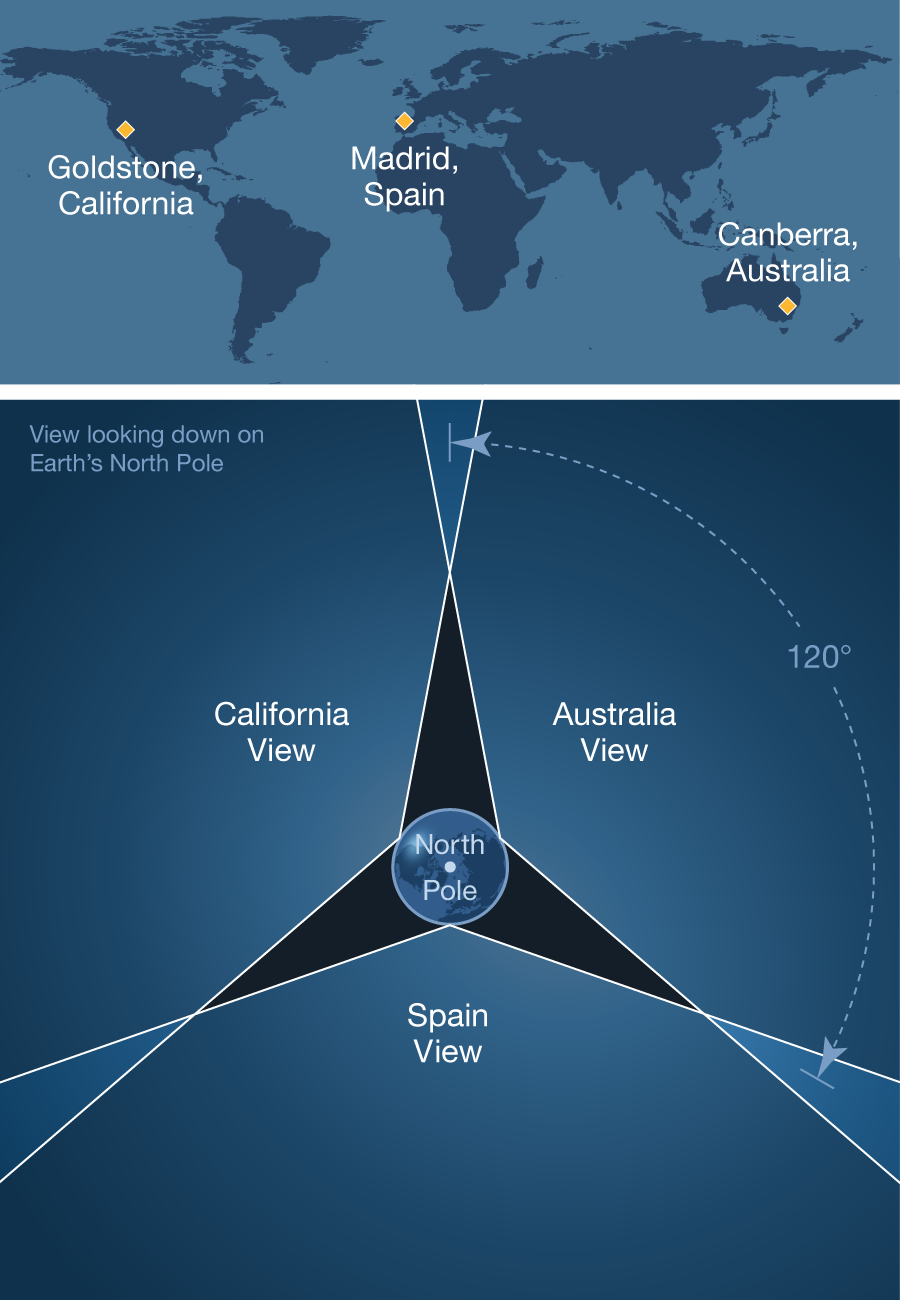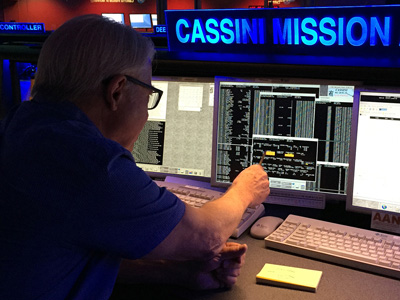Chapter 18: Deep Space Network
Objectives: Upon completion of this chapter, you will be able to describe the Deep Space Network's seven data types and trace data flow. You will be able to describe the three Deep Space Communications Complexes, and compare five types of Deep Space Stations. You will be able to describe advantages of arraying and cite planned improvements in the DSN.
The NASA Deep Space Network is an international network of facilities managed and operated by JPL's Interplanetary Network Directorate, IND. The DSN supports interplanetary spacecraft missions, radio astronomy, radar astronomy, and related observations for the exploration of the solar system and the universe. The DSN also supports selected Earth-orbiting missions.
The DSN is the largest and most sensitive scientific telecommunications system in the world.
It consists of three deep-space communications complexes, DSCCs, placed approximately 120 degrees apart around the world: at Goldstone near Barstow in California's Mojave Desert; at Robledo near Madrid, Spain; and at Tidbinbilla near Canberra, Australia.
The Network Operations Control Center, NOCC, is in building 230 at JPL. The strategic placement of the DSCCs permits constant observation of spacecraft on interplanetary missions as the Earth rotates.
The DSN enjoys a rich history that is closely intertwined with the history of the space age and the cutting edge of development in telecommunications technology. This page offers a number of images. Each image, when selected, displays an extensive caption describing a part of the DSN's history.
The DSN is an extremely complex facility, but it becomes more easily comprehensible if you recognize its seven data types, as a context for learning about DSN subsystems, and how they relate to each other. In the past, each of these seven data types was associated with a separate DSN system.
Today, thanks to the Network Simplification Program, these have been consolidated into two DSN systems: Uplink (The Uplink Tracking and Command Subsystem, UPL) and Downlink (The Downlink Tracking & Telemetry Subsystem, DTT).
Here is a brief discussion of the seven DSN data types that are processed in the UPL and DTT:
- Frequency & Timing Data Type, F&T Any computer system, whether desktop or supercomputer, has an internal clock that directs every step of the computer's operations. F&T is the DSN's "internal clock." With precision and accuracy that are at the forefront of world class frequency and timing, the Frequency & Timing Subsystem is essential to nearly every part of the DSN, enabling the other six data types to exist.
At the heart of F&T are four frequency standards of which one is prime and the other three are backups. These include the hydrogen masers mentioned in Chapter 10, and cesium frequency standards. The master clock assembly produces time codes using the frequency standard as a reference. Every subsystem across the DSN, and nearly every assembly have an input of F&T data in the form of a reference frequency and/or time codes. Those subsystems having time code inputs interface via time code translators, TCTs.F&T synchronization is managed among all three DSCCs and JPL by keeping track of offsets in fractions of microseconds resulting from comparison of local F&T data with reference pulses received from Global Positioning System, GPS, satellites.
- Tracking Data Type, TRK
- The TRK data type includes Doppler, ranging, predicts, and DSN antenna control. Measurement of the Doppler shift on a spacecraft's coherent downlink carrier allows determination of the line-of-sight component of the spacecraft's velocity. Routine measurement precision is on the order of fractions of a millimeter per second. Ranging tones uplinked and transponded by a spacecraft enable navigators to determine an average distance to and from the spacecraft, with a routine precision of about one meter. Navigators use Doppler and range measurements to determine a spacecraft's trajectory, and to infer gravity fields of bodies that affect the spacecraft. Navigation team members create ephemeris files that the DSN uses to generate antenna pointing predicts and frequency predicts for uplink and downlink. Predicts are sent to DSN sites to enable acquisition and following of the spacecraft.
- Telemetry Data Type, TLM The word Telemetry is derived from the Greek "tele" (far off), and "metron" (measure). A spacecraft produces digital data to represent engineering measurements, such as the temperatures of parts of the spacecraft, and science data, such as images from its cameras. The spacecraft places symbols on its radio frequency downlink to represent the ones and zeroes that make up this data. The DSN Downlink Tracking & Telemetry subsystem recreates the spacecraft's digital data bit for bit by recognizing the downlinked symbols and decoding them. DSN then delivers the TLM data to the flight project for display, distribution, storage, and analysis, supporting spacecraft engineering management and eventual publication of scientific results.
- Command Data Type, CMD Flight projects send digital data to the spacecraft via the DSN Uplink Tracking & Command subsystem. Like telemetry-in-reverse, digital bits generated by the flight project are sent as CMD data to the spacecraft, which is able to recognize the bits as either flight software to load into its on-board computers, or as commands to control the spacecraft's activities.
- Monitor Data Type, MON MON data reports on the operation and performance of the DSN itself. The DSN Network Monitor & Control subsystem (NMC) collects data from assemblies throughout its subsystems. This MON data is used in various locations: within the DSCC to watch and control its own activities; at the Network Operations and Control Center at JPL for managing and advising DSN operations, and in flight projects to help with realtime coordination of operations. Flight projects typically select a subset of MON data to distribute and store along with TLM data to provide indications of, for example, the strength of the spacecraft's signal as received by DSN at any given time.
- Radio Science Data Type, RS As mentioned in Chapter 8, RS experiments use the spacecraft radio and the DSN together as a science instrument. RS investigators remotely control equipment in the DSN such as the Radio Science Receivers, RSR, to capture and record data on the attenuation, scintillation, refraction, rotation, Doppler shifts, and other direct modifications of a spacecraft's radio signal as it is affected by the atmosphere of a planet, the Sun, moons, or by structures such as planetary rings or gravitational fields.
Unlike the closed-loop receivers used by TRK and TLM, RS uses open-loop receivers and spectrum processing equipment. Rather than lock onto one discrete frequency, the open-loop equipment can observe a range of frequencies.
The JPL Radio Science System Group has an informative website. - Very Long Baseline Interferometry Data Type, VLBI VLBI can be applied to a number of investigations. Two or more widely separated DSN stations observe the same spacecraft, or a quasar, at the same time, using open-loop receivers, and record their data. The recorded data is taken to a special-purpose computer called a correlator for processing to produce a cross-correlation fringe pattern. Further analysis can precisely determine the relative position of the antennas. This investigation is called geodesy. With the antenna positions known precisely, VLBI can precisely determine the position of a spacecraft. VLBI can also produce synthetic aperture results such as images of astronomical objects.
In addition to the three DSCCs and the NOCC, the DSN also includes the following:
- the Demonstration Test Facility at JPL known as DTF-21 where spacecraft-to-DSN compatibility is demonstrated and tested prior to launch,
- the Merrit Island facility MIL-71 in Florida, which supports launches, and
- the Ground Communications Facility, GCF, which connects them all with voice and data communications. The GCF uses land lines, submarine cable, terrestrial microwave, and communications satellites.
All three DSCCs have generally the same makeup, although Goldstone, GDSCC, being closest to JPL, has some additional antennas, as well as research and development facilities not found at the others: Madrid, MDSCC, or Canberra, CDSCC.
Each DSCC has the following:
- A number of Deep Space Stations, DSSs. Each DSS comprises a high-gain, parabolic-reflector steerable antenna dish, and its associated front-end equipment such as low-noise amplifiers and transmitters. That's a DSS pictured near the top of this page. The DSSs are divided, according to their aperture size, into groups called subnets, for example the 70m subnet, the 34m subnet, and the 26m subnet. (Subnets are further identified by antenna type, as described on the next page.)
- The signal processing center, SPC. The SPC connects with all the DSSs at the DSCC, and houses the operations personnel along with the computers and other equipment within the UPL and the DTT that handle the seven DSN data types.
- Administrative offices, a cafeteria, and a visitor center.
The remainder of this chapter discusses the DSSs and their different capabilities, and describes the flow of TLM, MON, TRK, RS, and CMD data.







